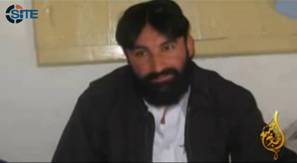
The Taliban confirmed that Badruddin Haqqani, one of the top leaders in the Haqqani Network, a Taliban subgroup that is closely allied with al Qaeda, was killed by US forces. Although the Taliban did not state how Badruddin died, he is known to have been targeted in a US drone strike in the summer of 2012, and has long been rumored to have been killed.
The Taliban confirmed his death in a video that was released by Manba al Jihad, "a media unit of the Haqqani Network within the Afghan Taliban," according to the SITE Intelligence Group, which translated the video. The video was published on Sept. 8 on Voice of Jihad, the Taliban's official website.
"While the Afghan Taliban initially denied these reports, the video confirms his death and includes a statement from Mullah Muhammad Omar acknowledging it," SITE stated [see LWJ report, Badruddin Haqqani 'is alive and healthy,' Taliban spokesman says, for the official denial by Taliban spokesman Zabihullah Mujahid].
"Footage shows Haqqani officials speaking about Badruddin, including Maulvi Sangeen [Mullah Sangeen Zadran] and Ahmad Jan Ghaznavi, and covers some of the operations in which he was involved," SITE continued. Sangeen, another top Haqqani network leader, is rumored to have been killed in a US drone strike late last week.
A Taliban fighter who participated in the June 25 suicide assault in Kabul said the attack was launched to avenge Badruddin. The fighter, who spoke in English, threatened "the Americans, and the Jews, and the non-Muslims, the European people."
"Did you, you martyred our leader, shaheed [martyr] hafiz [memorizer of the Qur'an] Badruddin Haqqani, rahimahullah [may Allah have mercy on him]," the fighter said, according to SITE. "You don't think we don't be happy about this, that you martyred our holy leader - you martyred our leader, and don't think you will be happy nowadays. Insha'Allah [Allah willing], know that we are going to get the revenge of our leader shaheed Badruddin Haqqani, and insha'Allah, you the leaders, you martyred ours, you martyred our leaders, insha'Allah, we have taken revenge for our leaders and we will take revenge for our leader shaheed hafiz Badruddin Haqqani, rahimahullah."
Badruddin is believed to have been killed in one of five drone strikes that took place between Aug. 18 and Aug. 24, 2012 in Pakistan's Taliban-controlled tribal agency of North Waziristan. Four of the five strikes took place in the Shawal Valley, an area known to be used by the Haqqani Network and a host of jihadist groups. The other took place in North Waziristan, the seat of power for the Haqqani Network [see LWJ report, Badruddin Haqqani rumored killed in US drone strike].
Badruddin was one of the Haqqani Network's most senior leaders. He is thought to have served as the top deputy to Sirajuddin Haqqani, the group's operational commander.
The US State Department added Badruddin to the list of Specially Designated Global Terrorists on May 11, 2011. In the designation, State said that he "sits on the Miramshah Shura [council], which has command and control over all Haqqani Network activities, and helps lead insurgents and foreign fighters in attacks against targets in southeastern Afghanistan."
The Miramshah Shura, also known as the Miramshah Regional Military Shura, is one of the Afghan Taliban's four regional commands. The US military and government often use the term "foreign fighters" to describe members of al Qaeda and allied terror groups operating along the Afghan-Pakistani border.
Jason Blazakis, the chief of the State Department's Terrorist Designations Unit, told The Long War Journal in May 2011 that Badruddin did indeed aid al Qaeda operatives in attacking US forces in Afghanistan.
"The foreign fighters supported by Badruddin include al Qaeda fighters," Blazakis said.
State also said that Badruddin was "believed to be in charge of kidnappings for the Haqqani Network." According to State, he "accepted responsibility for keeping New York Times reporter David Rohde hostage." Rohde was captured in November 2008, held in North Waziristan, and escaped in June 2009.
Badruddin was also one of several handlers for the fighters involved in the June 28, 2011 assault on the Intercontinental Hotel in Kabul. He was recorded while he issued instructions to one of the fighters, and was heard laughing during the attack that killed 11 civilians and two Afghan policemen as well as nine members of the attack team. The attack and the use of Pakistan-based handlers to direct the assault team is similar to at least three other attacks carried out by terror groups in the region, including Mumbai [see LWJ report, Haqqani Network directed Kabul hotel assault by phone from Pakistan].
Badruddin is one of nine Haqqani family members who have been designated by the US as global terrorists; all of them have ties to al Qaeda. His brother, Sirajuddin, is the overall leader of the Haqqani Network as well as the leader of the Miramshah Regional Military Shura. Siraj was designated by the State Department as a terrorist in March 2008; and in March 2009, the State Department put out a bounty of $5 million for information leading to his capture. US intelligence officials have told The Long War Journal that Siraj is a member of al Qaeda's top council.